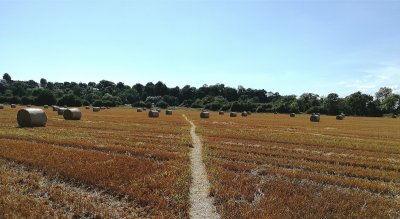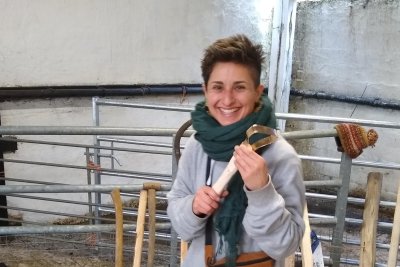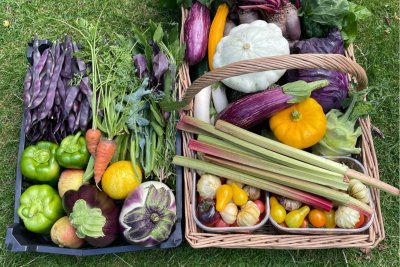Blogs • Sustainable Farming Campaign
Is there any other sector like farming?
I’m very interested in the economics of farming - why so little of the food pound reaches farmers. Where does it go? Why is there so much market failure? And if it does not work, how can we sort it and create more sustainable, responsive market suited to the future that farms must adapt to?

Economists often tell me that farming should operate like any other business. The laws of supply and demand, self-regulation, competition, subsidies are no different and so on... But I find it hard to agree. And with the news filled with so many stories linked to how well or badly our food system is ‘managed’ - from wildlife loss to obesity, from low wages to climate crises (not least the latest UN IPCC impact report) - I have been reflecting on why.
I suggest it is because that farming is multi-dimensional and multi-functional. And it is both these things in way that no other business sector is. But what does this mean?
Multi-dimensional* has struck me of late as relevant, with all the talk of tree planting or housebuilding in fields formerly producing food. The farm has four working dimensions:
- downwards - where the soil – an extraordinary, complex 4D process of biology, chemistry and physics, which we are only just beginning to understand - must be constantly nurtured.
- upwards - where the plant matter – be it grass, crop, animal, tree and farmer/worker which needs to be managed and protected against the weather, deer, pests, abuse and so on.
- And the third dimension - the east, west, north, and south - is managing how the land is used, using rotations and nutrient cycling and so on and tied in with a land use strategy which should ensure public needs are met, from climate mitigation to wellbeing
- The fourth dimension is that intricate view needed to see what the weather, the crops pests, the all-important markets and buyers, the workers, the policy shifts and investments, the markets and consumers …are doing and how it will affect the farm’s operation in the short, medium and long term.
All these dimensions are, in themselves, extremely complex. Yet the interplay between them can provide a unique set of outcomes vital to deliver safe, healthy food.
For me, the way in which the industry beyond the farmgate has ignored that interplay is the biggest calamity that needs reversing. They’ve demanded product specialisation and uniformity at ever lower prices, collated centrally and globally, to provide ever more processed food. We need better, far more responsive markets that can recognise these complexities and whch are obliged to deal fairly and not drive unhealthy or unsustainble food production.
What about the mutifunctional?
This phrase was well used in the 90s when EU Farm Commissioner Franz Fischler was proposing reforms to the Common Agriculture Policy to reflect better rural needs. 25 years ago, his ‘Cork Declaration’ described a range of economic activities to support not just agriculture and forestry, but also small businesses, tourism, the service sector and for producing nature and renewable energy. It failed... as big farm and food lobbies successfully pushed their governments to reject it.
But such an approach, supporting the multifunctional outcomes of farming within its rural (and periurban and urban settings) is as relevant now as it was then, despite the CAP reforms never taking off as they should have. And combined with new, urgent elements given the climate crisis. The ‘multifunctionality’ I believe is unique to farming (and sustainable forestry) and could include (in no particular order):
- A regular supply of affordable, safe, quality food, fibre, fuel and feed
- Good health from good food**
- ‘Six inches of soil’ that will continue to function – the unique factory floor of the business
- Decent profitability, good jobs and livelihoods and up and downstream of the farm too
- Thriving wildlife and ecology (water, air, natural systems) in and around farmland
- Heritage, landscapes, education, engagement and culture
- Climate mitigation (carbon capture and storage) and adaptation (flood controls, etc)
- Rural cohesion and vital support in times of emergency
- Tourism and leisure opportunities and wellbeing
I have missed many I suspect.
Whilst not I am suggesting UK farming does provide all this, it can.
But is any other industry - made up of largely SMEs, working with unpredictable nature and few workers - beleaguered or blessed by so many expectations?
But, again, it’s hard to deliver all these things - even if you want to or are, sometimes adequately, supported to - if buyers are squeezing, irresponsibly at the farm gate or while trade deals threaten to swamp your market with cheaper, lowers standard produce.
And the ‘affordable’ bit is certainly not in the farmers’ gift when on average, only 9% of the final price we all pay for food reaches them. Adding costs and value beyond the farm gate is an art form perfected by a sophisticated food and drink sector. And the billions spent on advertising and marketing junk food for instance is, I believe, a major part of the problem.
Why intervene?
Economists may argue that all these outcomes should come from markets, and from self-regulation by those who know their resources best, the land managers themselves. And that other sectors are similarly multi-dimensional and multi-functional (can you name them?). And that transparent and fair competition will drive everything – from resource protection to good jobs - without intervention.
But that does not work in farming and land use. ‘The tragedy of the commons’ is seriously at play here as we see nature severely depleted and how under regulation has led to the over- consumption and over-exploitation of resources like nature, soil, water. Obviously, the forces at play – who ultimately determine the decisions of farmers – tend to not make decisions based on what is best for society, but for profits and shareholder dividends. That's understandable.
But land use is a resource just far too precious to leave to market forces. To some degree that has been recognised by the new public money for public goods approach Defra have taken with new support schemes in England. That is welcome. As are calls for a land use strategies or farmeworks which are growing in the UK (e.g. The National Food Strategy Recommendation 3, and our Green and Pressured Land) and are already underway in Scotland. The House of Lords has a Land Use in England Committee now. I wonder whose voices will prevail in that mighty institution.
Solutions are plenty but they often fail to acknowledge these ‘multi’ issues.. and I believe there are some that think we need just 40 mega farms and we can entirely rewild the uplands to sort out carbon and nature...
I worry that the government, and some in the industry itself, want to see many more farms gone – the ‘small’ and the ‘inefficient’. This will make the industry more ‘competitive’ with ever larger, ‘efficiently’ run farms, often by contractors with little connection to the communities around. It is certainly the direction of travel over the past decades. Just last year we lost over 1,600 farm holdings a month. And new farm policies may accelerate this if governments are not careful.
We will lose so much, as myself and others like CPRE suggested back in 2017 – reflecting on the complex interactions and importance farms of all sizes have in the environment and in society.
I’m all for rewildling, and especially in places where nature and ecosystems desperately need to be restored such as peatlands. But the fear farmers’ have of mass tree planting for carbon credits - that as tenants they may be thrown off farms or farmers losing their core mission as food producers...is very real.
Yet wilder (multifunctional) farms with trees, shrubs and food and carbon and timber production, and suitable livestock, and sensitive tourists, I suggest could be the best outcome for many of the areas currently slated for plantations. And all farms, lowland and upland can rewild parts of their farms.
Are techno fixes the answer?
Given the huge problems of feeding the world in ways that also protect and nurture wildlife restoration, some suggest we should feed ourselves largely without land, so nature can recover. Use vast vats of fermenting yeasts and microbes engineered in their DNA to produce perfectly nutritious and tasty proteins, fats and carbs. It may come to that. Who knows?
Vertical farms and the like are sucking in millions in investment. The low land take and employment needs, full control of all inputs and outputs in a sterile environment, and rather sexy visuals of high-rise greenery are extremely appealing to investors right now. I am not talking genetic engineering and so on, as the promise of this tech is so far removed from realities of real farming (as described above).
But I believe we do have the answers to ensuring farming can continue to provide us with much of the food we need through soil-based farming. We are only just uncovering the true nature of soil interactions with fungi, microbes, plants and how that provides the nutrients – micro and macro – that we need. We lose that at our peril.
And there’s another ‘multi' to add to all this which is about innovation through working together not automatically reaching for the high tech stuff.
Called ‘interactive innovation through multi-actor partnerships’ – the Soil Association describes how we need innovation on farm and in the supply chain with diverse collaborators from different backgrounds and disciplines (farmers and growers including new entrants, policymakers, researchers, citizens and interested stakeholders) working together, “exploring complex problems and developing wide-ranging solutions collaboratively that support a systemic change”. The solutions would really flow from this kind of approach and it recognises the complexity of farm systems unlike most techno fixes (though they have their place).
In conclusion
A well-managed agroecological shift for all farmers – that takes account of that multidimensional and multifunctionality and multi-actor - and which is supported and nurtured by good policies and decent, more responsive and mostly closer markets and community wealth building - is the dream ticket.
*apologies to genuine mathematicians - the real, mathematical 4th dimension is beyond me – I’m just stealing a descriptive tool
** We argued repeatedly, and alongside experts, that public health is a ‘public good’ that can be provided by farming (diversity, nutrients, toxins and pollution, antibiotics, physical and mental wellbeing) so should be in the Agriculture Act as an outcome. We lost and the economists won. But also, it is fair to say that the fate of a product, post farmgate is not, usually, in the farmers’ gift.
Published Tuesday 1 March 2022
Sustainable Farming Campaign: Sustain encourages integration of sustainable food and farming into local, regional and national government policies.





